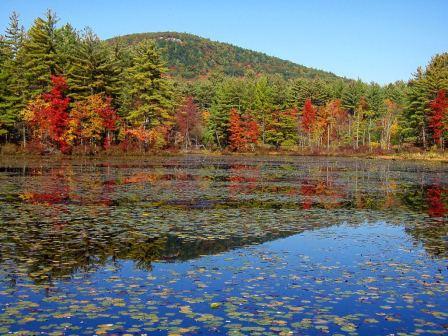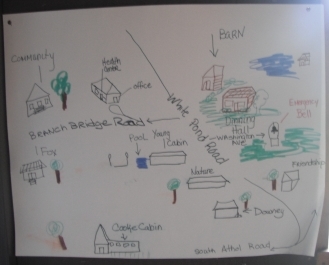Mount Grace Twenty-Fifth Annual Meeting: Bob Durand Speaks about the Tully Initiative
Mount Grace 25th Annual Meeting: Bob Durand Speaks
A Passion for Forested and Agricultural Land Conservation
By Bob Durand, Massachusetts Secretary of the Environment (1999 – 2003)
It’s great to be back at Mount Grace. I think it was 10 years ago that I spoke at the 15th annual meeting. I remember then the passion of your board, it’s board president and executive director for land conservation having had the privilege to work with them my four years as Secretary of Environmental Affairs under Governor Paul Celluci and Governor Jane Swift. So congratulations on getting to 25 years with 25,000 acres preserved.
Leigh asked me to say a few words about the Tully initiative. Before I do, I thought by way of background that you should know I have a special affinity to this part of the state - growing up in Hudson, Massachusetts, listening to stories from my father about living in Athol where his parents, my grandparents, worked as many French Canadian Catholics did for the burgeoning shoe industry of the time, and playing along the Millers River.
It would be years later that many of my hunting and fishing buddies would come out to the North Quabbin to hunt grouse and fly fish for trout, and still years after that I met Senator Bob Wetmore who I sat beside for 9 years in the state senate when we would share stories about the beautiful natural resources in his district.
So as a newly appointed Secretary of the Environment, when I was invited to the dedication of the Wetmore property round Jacob’s Ridge, I was once again smitten by the seemingly unregimented landscape before me. It reminded me of places of my youth that have been subsequently fragmented by roads, bridges and developments. I said to my staff at that time, we need to do everything in our power to protect this valuable resource. Around this time I had been talking with Keith Ross about the North Quabbin Landscape Partnership, and having made a promise to Secretary Hank Foster and later to David Foster of the Harvard Forest not to forget the forests of Massachusetts as Secretary of the Environment, all of the pieces were coming together.
While serving as a state senator and chair of the Natural Resources and Agriculture Committee, it had been on an international trip to Russia where I was introduced to the first bio-reserve. Everything clicked. If not in Massachusetts, why not? Having seen the development sprawl along Interstate 128, Interstate 495,and I-190 near Worcester, I felt we only had a decade to preserve the open spaces and wildlife habitat that are necessary to ensure quality of life that will connect future generations to nature.
So it was in the fall of 2000, I met Leigh Youngblood at Ralph Long’s restaurant in Athol with Chuck Anastas, my chief of staff, and Arthur Bergeron, my under secretary for land protection. I had the power of 5 state agencies and 3500 employees. Leigh had herself and one staff person. I told Leigh our predicament, we wanted to protect 200,000 acres of land and create a couple of bio-reserves of 15,000 acres or more around Massachusetts, and we only had a few years to do it. I asked her if she could spend over a million dollars on protecting 1000 acres of land within the Tully area in a year, and we promised more funding the following year if she could – a lot more funding. You could see the wheels turning and honestly she said I can try, but I’m going to need more help!
The Tully Valley Forests and Lands Initiative was launched over tuna fish sandwiches and soda. The primary goal of the Tully Initiative is to expand existing public and private lands protection in order to protect biodiversity while keeping land in private ownership and actively managed for forestry, agriculture, and passive recreation.
Mount Grace, along with New England Forestry Foundation, the Trustees of the Reservation, North Quabbin Land Trust and Massachusetts Wildlife and the Massachusetts Department of Conservation and Recreation were about to launch a national model for land conservation, not only in this state but throughout this country. Building on the vision of the North Quabbin Regional Landscape Partnership and Leigh’s passion for the Tully Valley, my response was not as a cabinet secretary or politician but more as an avid outdoorsman. I saw an irreplaceable landscape that must be protected for the many different uses this valley supports - one of the largest continuous tracts of forestland in southern New England. But small patches of development threatened to fragment the valuable block of forests.
The challenge was to defragment a landscape before it was too late.
Knowing that the state is suspect in this part of the state - after all, we flooded 4 towns to create the Quabbin and Shay’s Rebellion started not too far away - we thought our goals would be better met by local people. So, instead of, “Hi we are from the state and we are here to help,” we went with the local presence – Mt. Grace – a well respected and established land trust with dynamic leadership.
- Focus on the area inside the Tully trail loop first with personal contact to landowners
- Send out letters to owners in the entire four town focus area explaining the value of conservation Restrictions on working farms and forests and the need to defragment the landscape
- Find a way to support the town assessors to improve their operation
- Streamline the state land acquisition process for Tully
- Support a landowner collective of Tully conservation restriction owners
And we had the three l’s to get it done….land, land trust and Leigh.
I still have the memo from Bob O'Connor, Kristen Foord, Jack Buckley, and Arthur Bergeron with the bullets written on August 2nd.
Phase one: First 3 months, 25 landowners received information packets, telephone calls and personal visits. 5 land protection projects closed.
Phase two: 400 landowners of 20 acres or more contacted. 38 landowners closed.
Phase three: 540 landowners contacted. 61 closings.
We offered free appraisals without their obligation to sign up. I remember being overwhelmed that 4,200 acres comprised of more than 80 tracts, owned by 43 different landowners in four towns were protected in just a 6 month period. Who was this woman? It was her willingness to take a chance, a risk that other larger land trusts wouldn’t have taken. Along with great partners like NEEF, the National Environmental Education Foundation, the Trustees of the Reservation, and other land trusts, the federal agencies, state and local agencies and their support, on December 3, 2002 on a cold winter day along with Senator Brewer, we dedicated the North Quabbin Bioreserve - the first of two bio-reserves dedicated during my tenure as secretary.
After two years, we had protected 9,100 acres and defragmented a landscape which serves as a national model for larger landscape scale land protection. It has left a lasting legacy in this valley - protecting and enhancing the irreplaceable plant, wildlife and bird species all while creating recreational opportunities that maintain the Tully Valley’s unique rural character for generations to come – and protecting a large landscape using primarily conservation restrictions that allow public access and encourage sound forest management while keeping most of the land in private ownership.
One of the tools used in land protection here in the valley and across the state is the Community Preservation Act, as Jay Rasku knows so well. And as many of you know, the state match which was once at 100% has dwindled to around 25 % due to dwindling home sales and registry transactions – a loss of millions of dollars for open space protection and historic preservation.
Vice Chair of Ways and Means Steve Kulik, and sponsors Anne Gobi and Senator Stephen Brewer – now the chair of Ways and Means - have filed a bill called an act to sustain community preservation. The bill is now in Ways and Means in the House. I wanted to make you aware that many of our allies were able to attach language to the gambling legislature that passed the House to increase funding of CPA through casino gambling revenues. Though not enough to get us back to 75%, we are hopeful we can work with the senate next week to fix the discrepancy. We need your support. Rally at the Statehouse September 27th at 10:00 am.
Finally, the work you do is important as a member of Mount Grace. You are protecting our valuable watersheds and wildlife habitat. It is important work because you enhance the working forests and farmlands of the North Quabbin. And it is important because you are leaving a lasting legacy for your children and their children.
Thank you—Bob Durand,
Bob Durand is President of Durand & Anastas Environmental Strategies and a former Massachusetts Secretary of Environmental Affairs (1999-2003). Bob was a central figure in the Tully Valley Private Forest Lands Initiative, a two-year partnership involving Mount Grace, the Commonwealth, private landowners, and other conservation groups, which resulted in the protection of more than 9,100 acres through 104 separate conservation agreements. The Keynote Address was delivered on September 17, 2011 at the Mount Grace Land Conservation Trust Twenty-Fifth Annual Meeting held at Morgan Memorial Goodwill Fresh Air Camp in Athol, Massachusetts.
Thanks to Genevieve Fraser for providing the text of the speech!


